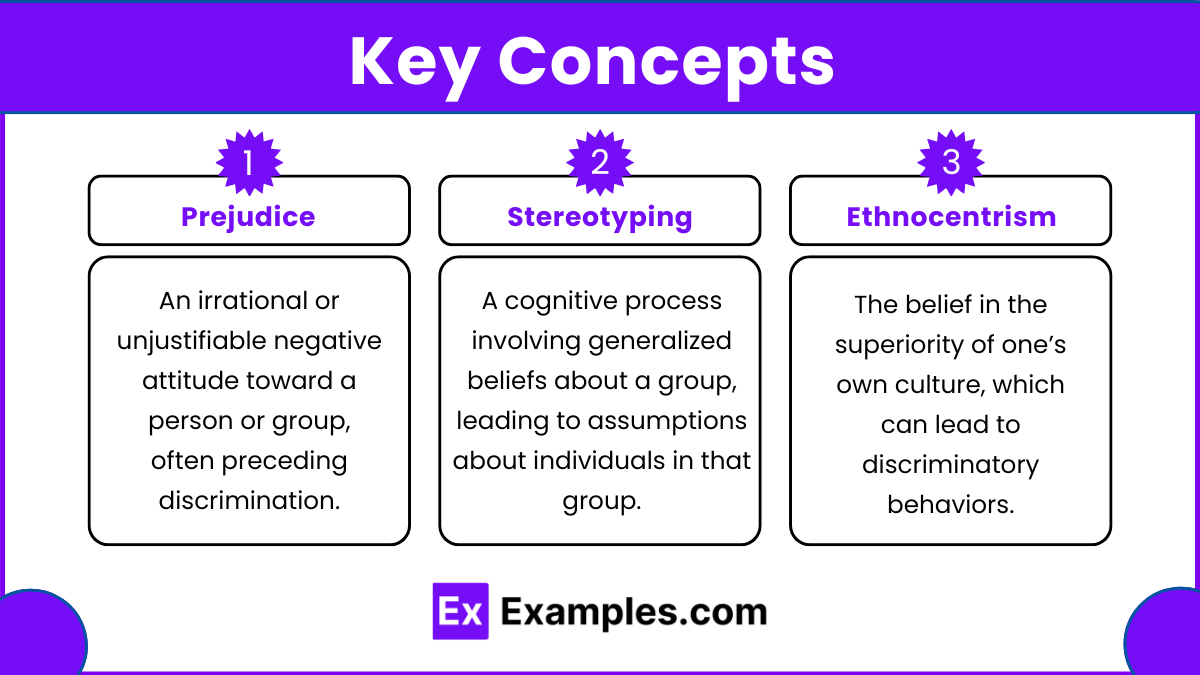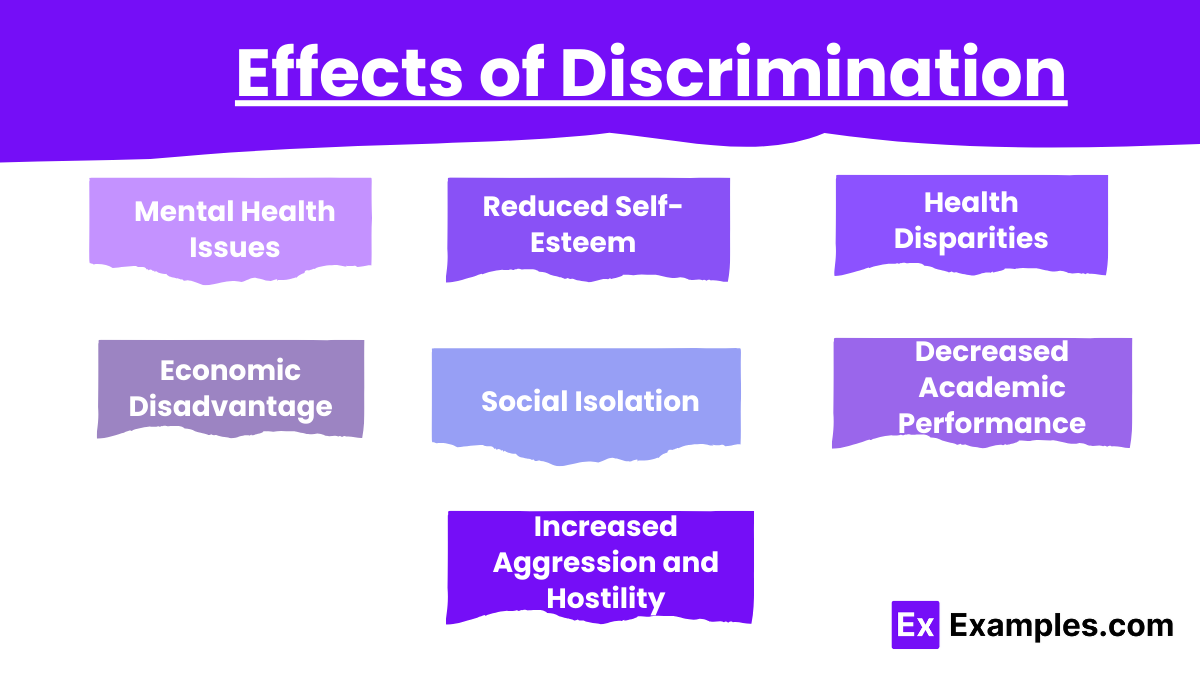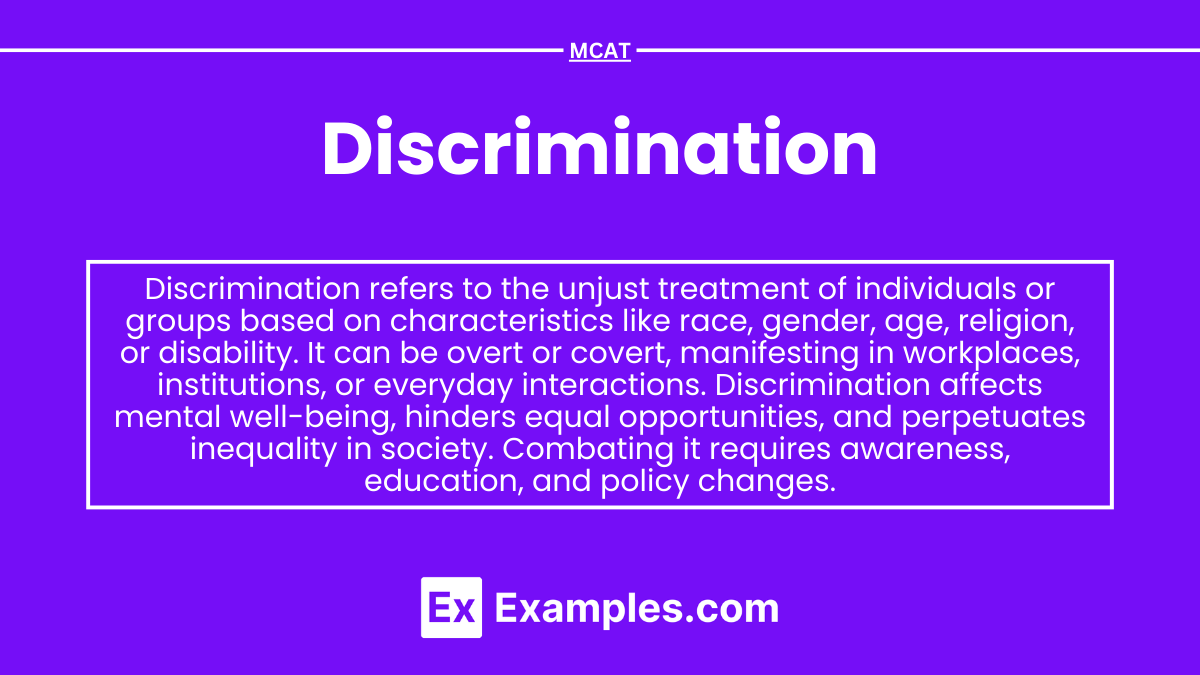Discrimination refers to the unjust or prejudicial treatment of individuals or groups based on characteristics such as race, gender, religion, age, disability, or sexual orientation. It arises from biases, stereotypes, and social inequalities, leading to unfair practices in various areas like education, employment, healthcare, and housing. Discrimination can manifest as direct actions, like exclusion, or indirect measures, such as policies that disproportionately affect certain groups. Addressing discrimination is crucial for creating an inclusive and equitable society, where everyone has equal access to opportunities and resources.
Learning Objectives
When studying "Using Discrimination" for the MCAT, your learning objectives should focus on understanding how discrimination can affect human behavior, social dynamics, and healthcare disparities. You should be able to identify and analyze different forms of discrimination, such as implicit biases, systemic inequalities, and individual prejudices, and their implications for patient care. Additionally, you should understand how discrimination impacts healthcare access, treatment outcomes, and patient-physician relationships, especially among marginalized groups. This knowledge should equip you to approach patient scenarios with cultural sensitivity, apply ethical principles, and effectively navigate the social and psychological determinants of health in clinical decision-making.
Key Concepts

Prejudice: An irrational or unjustifiable negative attitude toward a person or group, often preceding discrimination.
Stereotyping: A cognitive process involving generalized beliefs about a group, leading to assumptions about individuals in that group.
Ethnocentrism: The belief in the superiority of one’s own culture, which can lead to discriminatory behaviors.
Types of Discrimination

Individual Discrimination: Actions taken by individuals against other individuals or groups. It involves direct, personal discriminatory acts.
Example: A hiring manager refuses to hire qualified candidates based on racial or gender biases.
Institutional Discrimination: Discriminatory practices ingrained in the policies, laws, or procedures of social institutions, leading to systemic inequality.
Example: Laws that enforce segregation or policies that limit access to healthcare for certain groups.
Structural Discrimination: Results from the cumulative effects of historical discrimination across generations, impacting an entire group within a society.
Example: Socioeconomic disadvantages among marginalized groups resulting from generations of unequal access to education or jobs.
Interpersonal Discrimination: Occurs during direct interactions between individuals, where prejudice manifests as overt behavior.
Example: A service provider treating customers differently based on race or ethnicity.
Internalized Discrimination: When members of marginalized groups internalize negative stereotypes, leading to self-devaluation.
Example: A woman believing she is less competent in STEM fields due to societal stereotypes.
Effects of Discrimination

Here are seven effects of discrimination:
Mental Health Issues:
Discrimination can lead to stress, anxiety, and depression, severely impacting the mental well-being of individuals experiencing it.Reduced Self-Esteem:
Continuous discrimination can diminish a person's self-worth, leading to low self-esteem and a lack of confidence in personal abilities.Health Disparities:
Individuals facing discrimination often experience poorer physical health outcomes, such as higher rates of chronic illnesses due to stress and lack of access to healthcare.Economic Disadvantage:
Discrimination in the workplace can lead to unequal pay, limited job opportunities, and fewer chances for career growth, perpetuating economic disparity.Social Isolation:
Discrimination can lead to a sense of exclusion, resulting in social isolation as individuals may feel alienated from society.Decreased Academic Performance:
In educational settings, discrimination can negatively impact academic performance and participation, affecting long-term learning and success.Increased Aggression and Hostility:
Experiencing discrimination can contribute to feelings of anger, frustration, and hostility, which might manifest in aggressive behaviors or social conflicts.
Examples
Example 1. Healthcare Disparities
In healthcare, discrimination often results in unequal treatment of patients based on race, ethnicity, or socioeconomic status. For instance, patients from marginalized communities might receive lower-quality care, be misdiagnosed, or be denied access to certain medical procedures due to implicit biases among healthcare providers. This form of discrimination leads to poorer health outcomes, increased mortality rates, and higher rates of chronic illnesses in these communities.
Example 2. Workplace Inequality
Discrimination in the workplace is commonly observed through hiring practices, promotions, and wage disparities. Women, people of color, and individuals from the LGBTQ+ community often face barriers to career advancement due to stereotypes or biases. For example, women might be overlooked for leadership roles, or employees of certain racial backgrounds might be assigned lower-paying roles despite having similar qualifications as their peers. This kind of discrimination reinforces the gender and racial wage gap, affecting economic opportunities.
Example 3. Educational Barriers
Discrimination in education can manifest through limited access to resources, biased disciplinary actions, or under representation in certain academic fields. For example, students from low-income neighborhoods may attend underfunded schools with fewer opportunities for advanced courses, extracurricular activities, or college counseling. This discrimination limits their academic potential and perpetuates generational cycles of poverty and social inequality.
Example 4. Housing and Real Estate
In the housing sector, discrimination can be seen through practices like redlining, biased mortgage lending, and rental disparities. For instance, people of color often face challenges in securing loans or finding quality housing due to historical patterns of systemic racism. Discriminatory practices in housing contribute to residential segregation, restricting access to quality schools, healthcare, and employment opportunities, further perpetuating economic disparities.
Example 5. Criminal Justice System
Discrimination in the criminal justice system is evident through racial profiling, sentencing disparities, and unequal treatment in legal proceedings. For example, individuals from minority groups may face higher rates of arrest, longer sentences, and less access to legal representation compared to white individuals accused of similar offenses. This systemic discrimination reinforces social stigmas, limits economic mobility, and contributes to higher rates of incarceration among marginalized groups.
Practice Questions
Question 1
Which of the following best defines discrimination?
A) The belief that one’s own culture or ethnicity is superior to others.
B) The act of treating people differently based on characteristics such as race, gender, or age.
C) The process of categorizing people based on their characteristics without judgment.
D) The positive interactions between different cultural groups.
Correct Answer: B) The act of treating people differently based on characteristics such as race, gender, or age.
Explanation: Discrimination involves unfair or prejudicial treatment of individuals or groups based on characteristics like race, gender, age, religion, sexual orientation, or disability. It is an action or behavior that results from prejudice, whereas prejudice is a belief or attitude. Unlike simple categorization (option C) or ethnocentrism (option A), discrimination has an active component of treating others differently, usually in a negative way.
Question 2
What is an example of institutional discrimination?
A) A hiring manager who refuses to hire applicants based on their age.
B) An employee making offensive jokes about a colleague’s ethnicity.
C) Laws that segregated public schools based on race.
D) A person who avoids socializing with people from different cultural backgrounds.
Correct Answer: C) Laws that segregated public schools based on race.
Explanation: Institutional discrimination refers to discriminatory practices, policies, or laws that are embedded within and carried out by institutions (e.g., schools, governments, businesses). Option C, where laws enforced segregation, is a classic example, as it involves an official policy that discriminates against a group of people. Other options involve individual or personal discrimination rather than systemic or institutional discrimination.
Question 3
Which of the following is a characteristic of covert discrimination?
A) It is always intentional and overt.
B) It is subtle and may be unintentional.
C) It always involves physical violence.
D) It is easier to recognize and address than overt discrimination.
Correct Answer: B) It is subtle and may be unintentional.
Explanation: Covert discrimination is often subtle, disguised, or hidden within social interactions or institutional practices. It may be unintentional and difficult to detect, as it involves indirect actions or unconscious biases that impact people unfairly. Unlike overt discrimination, which is direct and clear, covert discrimination operates in ways that are less obvious, making it harder to address and resolve (contrary to option D).


